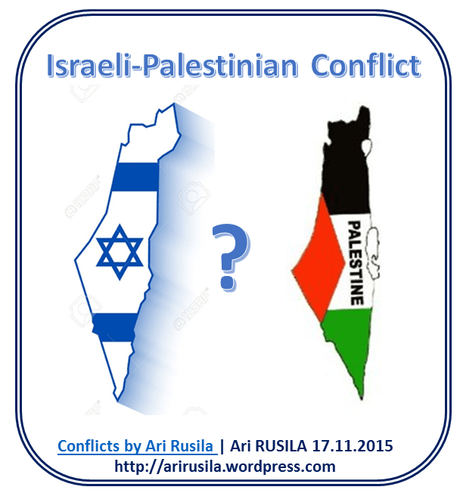 The Middle East peace process – mainly the Israel/Palestine part of it – has stagnated over the last decade. Whether or not to start direct negotiations; between Israel and the Palestinian Authority or at the regional level; with or without preconditions; directly or through intermediaries; The Two-state model as the only goal or not; or whether unilateral actions would be a better option than continuing the current state of affairs. Has the third uprising – the intifada – already started or not?
The Middle East peace process – mainly the Israel/Palestine part of it – has stagnated over the last decade. Whether or not to start direct negotiations; between Israel and the Palestinian Authority or at the regional level; with or without preconditions; directly or through intermediaries; The Two-state model as the only goal or not; or whether unilateral actions would be a better option than continuing the current state of affairs. Has the third uprising – the intifada – already started or not?
The first intifada ended thanks to massive peace efforts – the Madrid Conference and the Oslo Accords; the second intifada ended with a massive military operation [Operation Defensive Shield], how will the 3rd intifada end when it possibly begins? These are some of the issues in the Middle East conflict. In this analysis, I aim to clarify the most important solution options for the Israeli-Palestinian conflict in relation to the current situation. Below my old options which still might be valid:
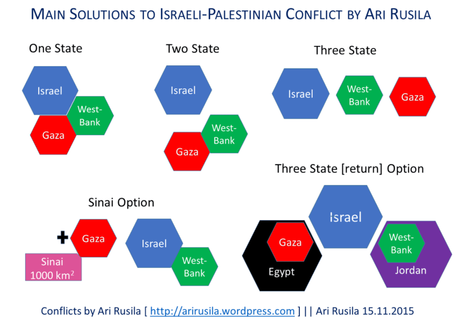
Some background
Since the 2000 Camp David summit, where U.S.-led negotiations failed to achieve a two-state agreement, the phrase “peace process” has served mostly to distract from the realities on the ground and to offer an excuse for not acknowledging them. For the past couple of decades, direct negotiations based on the ‘Two States’ model have been almost the only starting point and alternative for Israel, the Palestinian Authority and the international community in the Middle East peace process. Maintaining the negotiation process has even become a more important goal in itself than reaching an agreement. The negotiations have also constantly started and ended without any mentionable results and there is no promise of an agreement even in the foreseeable future.

For many years, the solution to the Israeli-Palestinian conflict has been the Two-State model. The majority of the Israeli public has expressed support for such a solution. This has also been accepted as a solution in all organizations, such as the UN Security Council and the General Assembly. In recent years however the One-State model has emerged more and more as reality. I myself have been propagandizing for years [without result] in favor of the Three-State (return) model.
One-State reality
According new analysis [Israel’s One-State Reality-It’s Time to Give Up on the Two-State Solution By Michael Barnett, Nathan Brown, Marc Lynch, and Shibley Telhami in Foreign Affairs May/June 2023] the authors claim e.g. following:
Prime Minister Benjamin Netanyahu’s return to power in Israel with a narrow, extreme right-wing coalition has shattered even the illusion of a two-state solution. Members of his new government have not been shy about stating their views on what Israel is and what it should be in all the territories it controls: a Greater Israel defined not just as a Jewish state but one in which the law enshrines Jewish supremacy over all Palestinians who remain there. Netanyahu’s new governments’ extremists boast of their mission to create a new Israel in their image: less liberal, more religious, and more willing to own discrimination against non-Jews. By not formalizing sovereignty, Israel can be democratic for its citizens but unaccountable to millions of its residents.
Israel’s radical new government did not create this a one-state reality but rather made it impossible to deny. The temporary status of “occupation” of the Palestinian territories is now a permanent condition in which one state ruled by one group of people rules over another group of people.
Palestine is not a state in waiting, and Israel is not a democratic state incidentally occupying Palestinian territory. All the territory west of the Jordan River has long constituted a single state under Israeli rule, where the land and the people are subject to radically different legal regimes, and Palestinians are permanently treated as a lower caste.
So according to the analysis mentioned above a one-state arrangement. Between the Mediterranean Sea and the Jordan River, one state controls the entry and exit of people and goods, oversees security, and has the capacity to impose its decisions, laws, and policies on millions of people without their consent.
One-State possibility as solution
There are 9.5 residents of Israel (including settlers in the West Bank), and these are about 2 Arab citizens living in Israel, including 350,000 residents of East Jerusalem. The number of Palestinians in the West Bank is estimated to be between 2 and 2.5. In addition to this, about 2 million Palestinians live in the Gaza Strip.
The INSS memorandum (Resolving the Israeli-Palestinian Conflict: The Viability of One-State Models) seeks to explore whether it is possible to implement a one-state model that is both Jewish and democratic.
The four one-state solution models – according to the INSS memorandum – between the Mediterranean Sea and the Jordan River are the following:
1. A unitary state: A single state in the entire territory with no internal borders.
2. A state with a Palestinian autonomy: A state in which the Palestinians have self-rule within a Palestinian autonomous area.
3. A federal state: A state divided into Jewish and Palestinian districts, in which the districts have broad powers at the district level, but the centralgovernment has authority at the national level.
4. A confederation: A model with two states—one Palestinian and one Jewish (Israel)—with a defined and open border between them. A joint Israeli and Palestinian government would function at the confederate level in specific areas of authority, such as external security and foreign trade.
Each model is examined according to an array of parameters: the territorial division; the status of the settlements; the status of Jerusalem; aspects of citizenship and residency; governmental authority; the involvement of the Palestinians in government; freedom of movement within the state; the refugee issue; security aspects; social aspects; economic and civil aspects; preservation of the state’s Jewish character; preservation of the state’s democratic and liberal character; the implications for Israel’s Arab citizens; the implications for the Palestinian Authority; the status of the Gaza Strip; and the execution of the model and its feasibility. After analyzing these factors, the likelihood of the model’s success as a permanent solution to the Israeli–Palestinian conflict is assessed.
 The models analyzed in the note are based on the temporal continuity between Jews and Palestinians, while the prevailing Two-state model connection is based on the idea of separation. This solution has necessary shortcomings, because it requires an agreement to divide the land, and the care is also in the evacuation border facilities on the West Bank.
The models analyzed in the note are based on the temporal continuity between Jews and Palestinians, while the prevailing Two-state model connection is based on the idea of separation. This solution has necessary shortcomings, because it requires an agreement to divide the land, and the care is also in the evacuation border facilities on the West Bank.
According to the memorandum’s analysis, none of the one-state models appear to be conducive to achieving a permanent, lasting and successful solution to the conflict. Because of the deep-rooted animosity between the two populations in recent decades – cultural, social and economic tensions are difficult to disentangle; free movement would restore the spread of terrorism from the West Bank throughout Israel.
Further, full and equal citizenship rights for Palestinians would irreversibly change the Jewish character of Israel. All models to be implemented require agreements with the Palestinians, causing endless disputes.
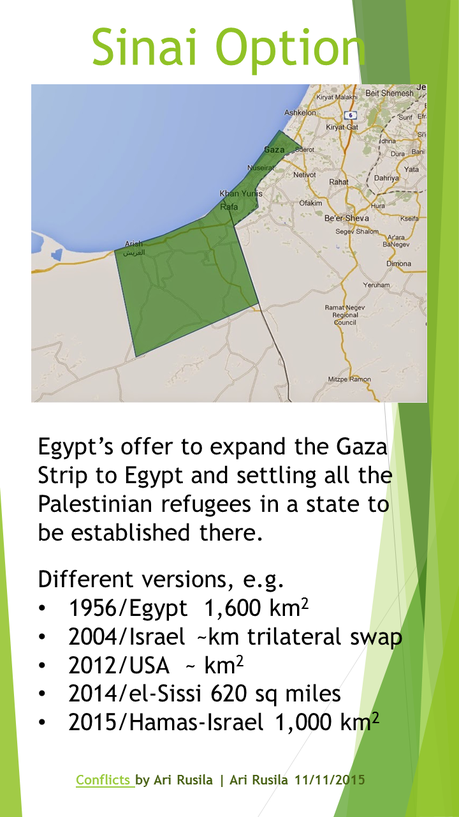 The confederation model presented in the memorandum might be more natural in the so-called Jordan option, in which case Palestine and Jordan would form a federal state or a confederation. Jordanian option was not considered in the memorandum. Although a significant proportion of Jordanians are already West Bank Arabs (Palestinians), the implementation of this model will be problematic in the near future as it may challenge the continuity of the Kingdom of Jordan, i.e. the Hashemite regime.
The confederation model presented in the memorandum might be more natural in the so-called Jordan option, in which case Palestine and Jordan would form a federal state or a confederation. Jordanian option was not considered in the memorandum. Although a significant proportion of Jordanians are already West Bank Arabs (Palestinians), the implementation of this model will be problematic in the near future as it may challenge the continuity of the Kingdom of Jordan, i.e. the Hashemite regime.
According to the memo, the One-State model as a solution to the conflict between Israel and Palestine based on the union of both nations – at least in the short term – seems impossible. Thus, the Two-State model seems to be a more permanent possible solution, despite its shortcomings.
Two-State solution
To this day, I cannot understand why the Palestinian leadership did not accept the far-reaching and unprecedented proposal I offered them. My proposal included a solution to all outstanding issues: territorial compromise, security arrangements, Jerusalem and refugees.
( How to Achieve a Lasting Peace: Stop Focusing on the Settlements By Ehud Olmert Israel PM 2006-2009)
A couple of decades the international community has preached a doctrine of ‘Two states for two peoples’, without any progress for its implementation. Sure also in my opinion a two-state solution might be both good and possible. The final status agreement – negotiated compromise – has been very close at least since the Beilin-Abu Mazen understanding / agreement / plan (1995) where nearly all issues were agreed. The Olmert proposal (2008) was probably the last serious try (both plans can be found from my document library ). These plans have been refined many times and serious work can be seen e.g. in leaked Palestine Papers/PaliLeaks (More in ”Pali-Leaks, land swaps and desperate search of peace” ).

The endgame with 2-state solution will probably be according to The Clinton Parameters . The key element with 2-State Solutions are negotiated borders based to pre-1967 armistice lines with land swaps; the state of Palestine as the homeland of the Palestinian people and the state of Israel as the homeland of the Jewish people
The three-state solution
In my view, Israel is now drifting towards – or already is – the reality of a de facto One State, jeopardizing the country’s future as either a democracy or a Jewish state. At the same time, the Two-State model is increasingly proving to be a utopia, and the road maps leading to it are turning out to be dead ends. I myself have long advocated for the Three-State (return) model – also called the no-state option – which, in my opinion, offers the most pragmatic solution to the Israeli-Palestinian conflict. In this 3-state scenario, Amman controls the West Bank and Cairo controls Gaza. This model also includes the idea of the Jordanian option, meaning the development and recognition of Jordan as a state of Palestine and the Palestinians. As for Gaza, the ‘Greater Gaza’ will become possible with the Sinai option [More about ‘Sinai Option’ in my article: Sinai Option again].
For 19 years, Judea and Samaria were part of Jordan and its population were Jordanian citizens, and even (Trans)Jordan itself was once separated by the British mandate government from Palestine as a place for the Arabs of the region to live. The advantage of the 3-state model would be for Israel, in the case of Jordan, a neighbor with whom it has had a peace agreement since 1994, in the case of Egypt, a neighbor with whom peace has been agreed since 1978. In the case of the Palestinians, the advantage would be access to a part of already developed state structures; regional self-governance solutions – Gaza autonomy, the Arab areas of the West Bank as federal or confederated parts of Jordan – would enable the preservation of the Palestinians’ own cultural identity, if necessary.
In my view, this ‘Three States’ [restoration] model is both pragmatic and feasible, and more relevant than ever. The settlement restores the situation – excluding Israeli settlements in Area C – to the way it existed between the 1949 armistice arrangements and the 1967 ‘Six Day War’.

The way forward
Throughout two decades of the Israeli-Palestinian “peace process,” direct negotiation with the aim of a Two-State solution has been perceived as the only paradigm of international community and it has been the main option for Israeli and Palestinian authorities. To keep negotiations ongoing has come de facto as the goal in itself instead of the means to reach an agreement. The failure to reach an agreement has given excuses to the politicians on both sides, allowing them to blame the other party for failure to progress, and destroying the belief that an agreement is possible in the foreseeable future.
As possible solutions for Israeli-Palestinian conflict there has been besides 2-State solution also a binational One-State solution, partial solutions like Sinai and Jordan Options and different variations of Three States solutions. One of course easy ‘solution’ is zero-option – ‘frozen conflict’ or ‘status quo’ scenario which can be implemented also through pseudo-talks. Today also unilateral actions – instead of vain negotiations – can pave the way towards some solutions.
So the one-state reality is the worst scenario for the solution of the Israel-Palestine conflict. Even worse could be forced deportation of Palestinians from the West Bank outside of Israel borders but this option might be only a dream among Israeli right-wing extremists.
Now the The Middle East peace process is at a crossroads. In my opinion there is three main pathways to solution of Israeli-Palestinian conflict – zero-option might be realistic during this government, but it is not the solution – and they are following:
- (Re)starting negotiations,
- Constructive unilateralism, and
- Cold Peace
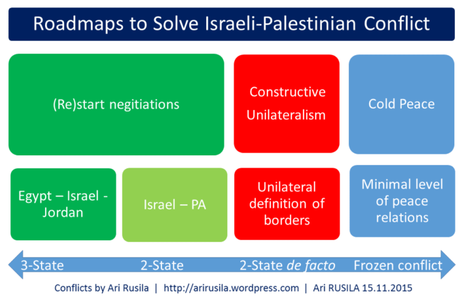
According to the idea of Constructive unilateralism, the international community should adopt a paradigm that allows all stakeholders – Israel, Palestinians, the US and the other players – to take independent steps that will advance a reality of two states.
 If peace negotiations don’t start, they fail again or regional solutions can’t be realized this time or other stakeholders are not ready to adopt Constructive unilateralism approach, so in that case from my viewpoint Israel could independently implement what I call a ‘Cold Peace Solution’, a minimal level of peace relations, where Israel would annex main settlements from West-bank inside the security fence and return to negotiations when both parties feel need to make a long term deal. This solution in my opinion is one way forward and it even might be possible to implement.
If peace negotiations don’t start, they fail again or regional solutions can’t be realized this time or other stakeholders are not ready to adopt Constructive unilateralism approach, so in that case from my viewpoint Israel could independently implement what I call a ‘Cold Peace Solution’, a minimal level of peace relations, where Israel would annex main settlements from West-bank inside the security fence and return to negotiations when both parties feel need to make a long term deal. This solution in my opinion is one way forward and it even might be possible to implement.
If unilateral solutions are made in the framework of constructive unilateralism, this approach might be the right roadmap towards a more permanent two-state solution. Not so bad an option compared to the status quo anyway from my perspective.
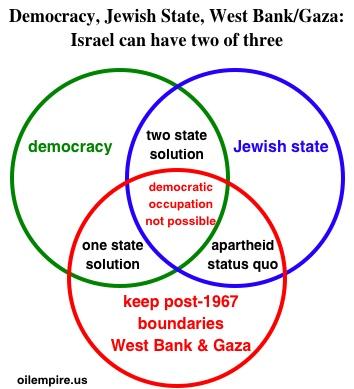
Sources e.g:
Resolving the Israeli–Palestinian Conflict: The Viability of One-State Models by Pnina Sharvit Baruch/INSS
My related articles:
- A Jordanian-Palestinian Confederation Is On The Move
- The Three-State Option could solve Gaza Conflict
- Constructive Unilateralism: Leftist Approach to Israel-Palestine Conflict
- Sinai Option again

